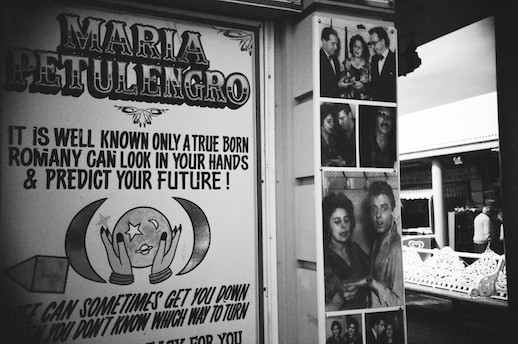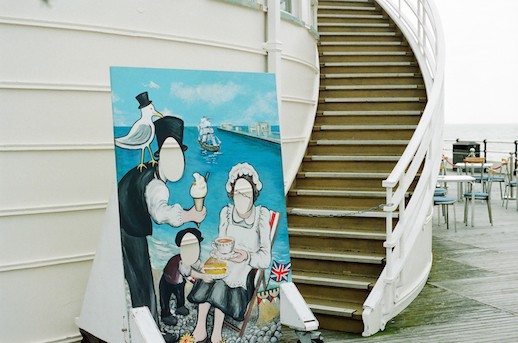 Words and pictures: Travis Elborough
Words and pictures: Travis Elborough
Etymologically speaking, our word ‘pier’ comes from the French ‘pile’, in Latin ‘pila’, for a ‘stone barrier’ and hence ‘pillar’. But the homonym ‘peer’ meaning both to look (‘to peer out’) and an aristocrat (‘a peer of the realm’) neatly ties together the two early motors of the seaside resort: that of royal visitors and the concept of a ‘sublime’ sea view.
And like gas lighting fitted to the Prince Regent’s Marine Pavilion and electric trams on Blackpool’s seafront, photography was among 19th century technological inventions first pressed into practical use at the seaside.
A plate-glass photographer was early addition to Brighton’s Chain Pier’s amusement. And it was at Freshwater on the Isle of Wight that Julia Margaret Cameron photographed Tennyson and her circle in Arthurian garb. Meanwhile, Olive Edis, Britain’s first female war photographer, had a studio in Sheringham and was initially acclaimed for her earthy portraits of Norfolk fishermen. But jobbing photographers gravitated to coastal resorts to provide holidaymakers for a record of their vacation.
Photographs were a magical means of preserving a fleeting moment – even if that moment required spending several minutes clamped in place to accommodate primitive exposure rates.
Like holidays themselves, fewer were taken, and the ones that were could be cherished for a whole lifetime.
Until recently, no British seaside promenade was without its ‘smudgers’ – those roving watch-the-birdy-men snapping visitors for a modest fee. For those languishing at home there were picture postcards to send– another boom area for photographers who supplied local scenes.
On the Continent, the vogue for picture postcards was stoked by the Paris Exposition of 1889, where a trade in photos of the Eiffel Tower became a full-blown craze. In Britain postcard mania was initially stymied by the Royal Mail, who only allowed cards to be sent through the post in 1894. A further six years passed before full picture cards were legalised and the ritual of dispatching ‘Wish You Were Here’ missives could finally begin in earnest.
To this day, seaside piers are vendor and star of postcards – with every pier’s kiosk stuffed narcissistically with racks of sun-bleached, curly-cornered representations of themselves.
But then seaside piers made ideal subjects for early photographers. Like the Eiffel Tower itself, they were site-specific, architecturally dramatic – and remained rigidly static.
However, by 1890s, the photographer Paul Martin was prowling beaches with a camera wrapped in brown paper and disguised as a parcel. His documentary style – if not the parcelling – continued by the likes of Tony Ray Jones and Martin Parr.
The photographic arts found further outlets in seaside arcades with Kinoscopes and Mutoscopes – those What the Butler Saw crank-the-handle peepshow machines that confirmed that life below stairs, for all of its indignities, was still the best place to catch elegant ladies in states of undress.
These devices operated on the lines of flicker-books, with a sequence of stills being wound on to create the illusion of motion. And the first ‘cinematographe’ film exhibited outside London was screened at the Pandora Gallery in Brighton in March 1896. Coastal theatres and music halls were meanwhile to supply Hollywood with some of their first stars. Charlie Chaplin spent a season as part of a variety show on Southport Pier.
A significant British movie pioneer was the Brighton-based photographer Alfred Esme Collings. A former-business partner of William Friese-Greene, Collings turned a Hove tea garden into an film studio, and was responsible for ‘Woman Undressing’, supposedly the first ‘blue movie’. In 1896 he shot ‘Boys scrambling for pennies under the West Pier’ – a few flickery frames of lads in neck-to-knees bathing suits vainly striving to retrieve some coins on the shingle.
Like the mosaics splashed into life with water in ancient myths, the film poignantly conjures up The West Pier in all its glory and a lost world of imperial certainty – if only underscoring the rather dismal entertainment options for small children – and the cinema-going public. A world that was to be brutally shattered by the First World War and itself the subject of a coastal cinematic outing in Oh What a Lovely War – Richard Attenborough’s version of Joan Littlewood’s musical – with the tragedy of the conflict playing out to old music hall songs on film and on The West Pier.
Travis Elborough is Chisenhale Gallery Victoria Park Residency artist for 2014-15. More info here.
